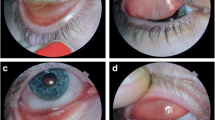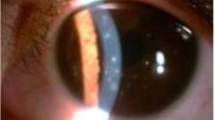Abstract
Introduction
A case of an 11-year-old boy presenting with a two-week history of a red, irritated right eye after handling a Chilean Rose Tarantula at an exotic pet exhibition. Examination revealed innumerable microscopic hairs embedded at all levels of the cornea. He was commenced on steroid drops with subjective and objective improvement at follow up.
Discussion
Tarantulas use their urticating abdominal hairs as a defense mechanism by flicking them into attackers’ eyes and skin, causing intense irritation. Ocular complications ranging from simple conjunctivitis, through to keratouveitis and even pan-uveitis with chorioretinitis, have been described in the literature. As exotic pets become more popular, the importance of wearing ocular protection when handling tarantulas should be stressed.



Similar content being viewed by others
References
Battisti A, Holm G, Fagrell B, Larsson S (2011) Urticating hairs in arthropods: their nature and medical significance. Annu Rev Entomol 56:203–220
Sheth HG, Pacheco P, Sallam A, Lightman S (2009) Pole to pole intraocular transit of tarantula hairs—an intriguing cause of red eye. Case Report Med 2009:159097
Hered RW, Spaulding AG, Sanitato JJ, Wander AH (1988) Ophthalmia nodosa caused by tarantula hairs. Ophthalmology 95:166–169
Stulting RD, Hooper RJ, Cavanagh HD (1983) Ocular injury caused by tarantula hairs. Am J Ophthalmol 96:118–119
Blaikie AJ, Ellis J, Sanders R, MacEwen CJ (1997) Eye disease associated with handling pet tarantulas: three case reports. BMJ 314(7093):1524–1525
Foelix R, Rast B, Erb B (2009) Palpal urticating hairs in the tarantula Ephebopus, fine structure and mechanism of release. JoA 292–298
Watts P, Mcpherson R, Hawksworth NR (2000) Tarantula keratouveitis. Cornea 19(3):393–394
Chang PC, Soong HK, Barnett JM (1991) Corneal penetration by tarantula hairs. Br J Ophthalmol 75:253–254
Conflict of interest
None.
Author information
Authors and Affiliations
Corresponding author
Rights and permissions
About this article
Cite this article
McAnena, L., Murphy, C. & O’Connor, J. “Tarantula Keratitis” a case report. Ir J Med Sci 182, 349–350 (2013). https://doi.org/10.1007/s11845-012-0885-7
Received:
Accepted:
Published:
Issue Date:
DOI: https://doi.org/10.1007/s11845-012-0885-7




